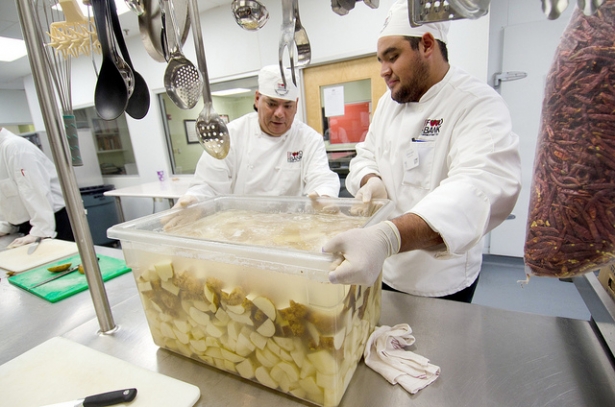THAT'S WHAT CRAZED, AUTHORITARIAN POLITICIANS DO AT THE BEHEST OF THEIR MASTERS, THE RICH!

San Antonio Food Bank workers Sergio Baiz (right) and Ed Rivas (left) prepare to cook mashed potatoes that will be served to low-income students. Under the House of Representatives' new budget, food assistance will be cut by $20.5 billion over 10 years. (U.S. Department of Agriculture /Flickr / Creative Commons).
A time-honored tactic of conservative lawmakers is to “starve the beast”by defunding government programs. In the case of food stamps—the quintessential whipping boy for budget hawks—they’re going a step further by trying to starve actual people.
The House of Representatives and Senate have proposed the United States “tighten our belts” by slashing billions of dollars from poor people’s food budgets. The main mechanism for shrinking the Supplemental Nutrition Assistance Program (SNAP) funding is the removal of “categorical eligibility.” Basically, most states have used this policy to streamline enrollment: Families are made eligible for food stamps based on their receipt of other benefits, such as housing or childcare subsidies. That often means broadening eligibility for working-poor families or those with overall household income or savings that exceeds regular, stricter thresholds for qualifying for food stamps.
Now the House and Senate farm bill proposals, particularly the House plan, seek to “save” billions more by cutting categorical eligibility. Under the House farm bill budget, which cuts $20.5 billion in SNAP over 10 years, benefits would be eliminated for “nearly 2 million low-income people, mostly working families with children and senior citizens,” according to the Center on Budget and Policy Priorities (CBPP). (The Senate bill also cuts SNAP but only by about $4 billion over 10 years). In addition, the cuts would devastate poor students, because SNAP eligibility has enabled 210,000 low-income children to qualify for free school meals. That means more hunger pangs for kids in the cafeteria, and an emptier refrigerator waiting for them at home. Meanwhile, their working-poor parents may find themselves buying cheaper, less nutritious food to stretch budgets, or turning to the local food pantry, or facing cruel trade-offs like delaying rent payments to pay for groceries or leaving a health problem untreated.
According to Stacy Dean, vice president for food assistance policy with the CBPP, the House proposal would end up cutting food stamps for people who hold minimal assets--poor families who have held onto a car to get to work, for example, or with savings just above $2,000. So at a time when wealth has declined for 93 percent of households, poor families who have built up a modest nest egg may be rewarded with the indignity of hunger. The typical food stamp family doesn’t fit the stereotype of the shiftless poor or “welfare queens,” Dean explained via email:
CONTINUE READING HERE!A typical working family that qualifies for SNAP benefits due to categorical eligibility is a mother with two young children who has monthly earnings just above the program’s monthly gross income limit ($2,069 for a family of three in 2013). On average, the families above that limit who qualify for SNAP as a result of categorical eligibility have combined child care and rent costs that exceed half of their wages. The approximately $100 per month in SNAP benefits they receive covers about one-fourth to one-fifth of their monthly food budget...
No comments:
Post a Comment